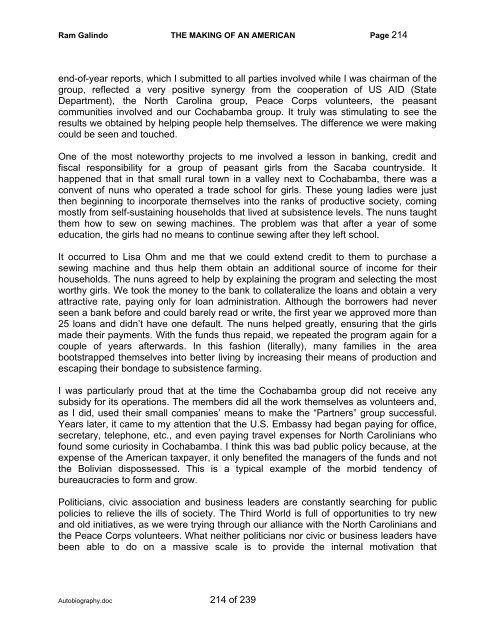Autobiography - The Galindo Group
Autobiography - The Galindo Group
Autobiography - The Galindo Group
Create successful ePaper yourself
Turn your PDF publications into a flip-book with our unique Google optimized e-Paper software.
Ram <strong>Galindo</strong> THE MAKING OF AN AMERICAN Page 214<br />
end-of-year reports, which I submitted to all parties involved while I was chairman of the<br />
group, reflected a very positive synergy from the cooperation of US AID (State<br />
Department), the North Carolina group, Peace Corps volunteers, the peasant<br />
communities involved and our Cochabamba group. It truly was stimulating to see the<br />
results we obtained by helping people help themselves. <strong>The</strong> difference we were making<br />
could be seen and touched.<br />
One of the most noteworthy projects to me involved a lesson in banking, credit and<br />
fiscal responsibility for a group of peasant girls from the Sacaba countryside. It<br />
happened that in that small rural town in a valley next to Cochabamba, there was a<br />
convent of nuns who operated a trade school for girls. <strong>The</strong>se young ladies were just<br />
then beginning to incorporate themselves into the ranks of productive society, coming<br />
mostly from self-sustaining households that lived at subsistence levels. <strong>The</strong> nuns taught<br />
them how to sew on sewing machines. <strong>The</strong> problem was that after a year of some<br />
education, the girls had no means to continue sewing after they left school.<br />
It occurred to Lisa Ohm and me that we could extend credit to them to purchase a<br />
sewing machine and thus help them obtain an additional source of income for their<br />
households. <strong>The</strong> nuns agreed to help by explaining the program and selecting the most<br />
worthy girls. We took the money to the bank to collateralize the loans and obtain a very<br />
attractive rate, paying only for loan administration. Although the borrowers had never<br />
seen a bank before and could barely read or write, the first year we approved more than<br />
25 loans and didn’t have one default. <strong>The</strong> nuns helped greatly, ensuring that the girls<br />
made their payments. With the funds thus repaid, we repeated the program again for a<br />
couple of years afterwards. In this fashion (literally), many families in the area<br />
bootstrapped themselves into better living by increasing their means of production and<br />
escaping their bondage to subsistence farming.<br />
I was particularly proud that at the time the Cochabamba group did not receive any<br />
subsidy for its operations. <strong>The</strong> members did all the work themselves as volunteers and,<br />
as I did, used their small companies’ means to make the “Partners” group successful.<br />
Years later, it came to my attention that the U.S. Embassy had began paying for office,<br />
secretary, telephone, etc., and even paying travel expenses for North Carolinians who<br />
found some curiosity in Cochabamba. I think this was bad public policy because, at the<br />
expense of the American taxpayer, it only benefited the managers of the funds and not<br />
the Bolivian dispossessed. This is a typical example of the morbid tendency of<br />
bureaucracies to form and grow.<br />
Politicians, civic association and business leaders are constantly searching for public<br />
policies to relieve the ills of society. <strong>The</strong> Third World is full of opportunities to try new<br />
and old initiatives, as we were trying through our alliance with the North Carolinians and<br />
the Peace Corps volunteers. What neither politicians nor civic or business leaders have<br />
been able to do on a massive scale is to provide the internal motivation that<br />
<strong>Autobiography</strong>.doc 214 of 239


